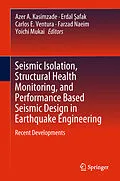This book features chapters based on selected presentations from the International Congress on Advanced Earthquake Resistance of Structures, AERS2016, held in Samsun, Turkey, from 24 to 28 October 2016.
It covers the latest advances in three widely popular research areas in Earthquake Engineering: Performance-Based Seismic Design, Seismic Isolation Systems, and Structural Health Monitoring.
The book shows the vulnerability of high-rise and seismically isolated buildings to long periods of strong ground motions, and proposes new passive and semi-active structural seismic isolation systems to protect against such effects. These systems are validated through real-time hybrid tests on shaking tables.
Structural health monitoring systems provide rapid assessment of structural safety after an earthquake and allow preventive measures to be taken, such as shutting down the elevators and gas lines, before damage occurs. Using the vibration data from instrumented tall buildings, the book demonstrates that large, distant earthquakes and surface waves, which are not accounted for in most attenuation equations, can cause long-duration shaking and damage in tall buildings.
The overview of the current performance-based design methodologies includes discussions on the design of tall buildings and the reasons common prescriptive code provisions are not sufficient to address the requirements of tall-building design. In addition, the book explains the modelling and acceptance criteria associated with various performance-based design guidelines, and discusses issues such as selection and scaling of ground motion records, soil-foundation-structure interaction, and seismic instrumentation and peer review needs.
The book is of interest to a wide range of professionals in earthquake engineering, including designers, researchers, and graduate students.
Autorentext
Carlos Ventura is a Civil Engineer with specializations in structural dynamics and earthquake engineering. Since 1992, he has been a faculty member of the Department of Civil Engineering at the University of British Columbia (UBC), Canada. He is currently the Director of the Earthquake Engineering Research Facility (EERF) at UBC, and the author of more than 450 papers and reports on earthquake engineering, structural dynamics and modal testing. Dr. Ventura has conducted research on earthquakes and structural dynamics for more than thirty years. Two of his most significant contributions in recent years are the development and implementation of a seismic structural health monitoring program for bridges in BC - the BCSIMS project - and the first network-based earthquake early warning system for schools and public institutions in BC, the BC-EEWN project. These two projects have contributed in a very significant manner to the seismic risk reduction efforts in British Columbia. In addition to his academic activities, Dr. Ventura is a recognized international consultant on structural vibrations and safety of large Civil Engineering structures. He is a member of the Canadian Academy of Engineering and of the Engineering Institute of Canada, and Fellow of Engineers Canada. He is also a member of several national and international professional societies, advisory committees and several building and bridge code committees.
Farzad Naeim is the President of Farzad Naeim, Inc. and CEO of Mehrain Naeim International, Inc., in Irvine, California. Prior to founding these firms, he was Technical Director at John A. Martin & Associates (JAMA) and its legal counsel. He regularly managed and facilitated activities of internal teams of experts in research and development activities, special seismic studies, and the design of specialized computer applications. For over 34 years Farzad's mission has been to take the best technology ...
Inhalt
Part I: Seismic Isolation Systems
1.1 New seismic isolation systems
1.2 Simple natural seismic isolation systems for buildings with no overturning moment
1.3 Development of resilient seismic response control with a semi-active system
Part II: New Developments on Structural Health Monitoring and Earthquake Early Warning Systems for Performance Assessment of Structures
2.1 BC Earthquake Early Warning System, A Program for Seismic Structural Health Monitoring of infrastructure2.2 Structural Health Monitoring: Lessons learned
2.3 Recent studies on earthquake performance assessment of Hagia Sophia in Istanbul
2.4 Evaluation of historical Merzifon Dönerta Mosque with a single dome2.5 Analytical and experimental modal analysis of a cold forme…
